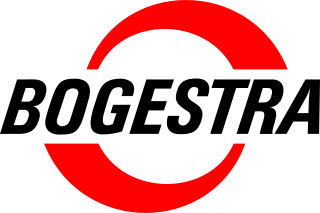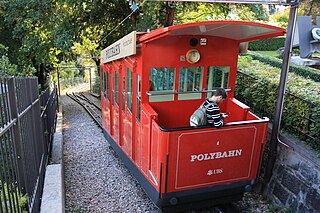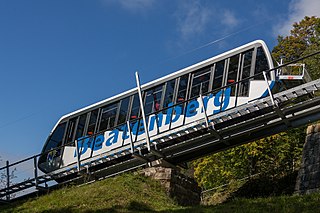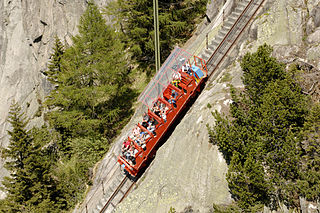
The Lauterbrunnen–Mürren Mountain Railway is a hybrid transport system in the Bernese Oberland area of Switzerland, which connects the villages of Lauterbrunnen and Mürren. The system consists of a connected aerial cableway, also known as the Grütschalpbahn, and an adhesion worked mountain railway. The cableway replaced a funicular, on the same route, in 2010.

The Bochum-Gelsenkirchener Straßenbahnen AG, abbreviated BOGESTRA, is a public transport operator in the Ruhr area, most notably in the cities of Bochum, Gelsenkirchen and Herne. As of 2012, the company operated, in whole or in part, 9 rail lines, and 65 bus lines. In 2012, BOGESTRA transported a total of 144.9 million passengers. The company is a member of the Verkehrsverbund Rhein-Ruhr (VRR) public transport association.

Rail transport in Austria is mainly owned by the national rail company ÖBB. The railway network consists of 6,123 km, its gauge is 1,435 mmstandard gauge and 3,523 km are electrified.

The Polybahn, also known as the UBS Polybahn, is a funicular railway in the city of Zürich, Switzerland. The line links the Central square with the terrace by the main building of ETH Zürich, which was formerly called Eidgenössisches Polytechnikum, and from which the railway derives its name. Previous names for the line include the SBG Polybahn and the Zürichbergbahn. The line is owned by the banking group UBS AG, and operated on their behalf by the municipal transport operator Verkehrsbetriebe Zürich.

The U-Bahn Serfaus is an underground air cushion funicular people mover system in the Tyrolian village of Serfaus in Austria.

Hohensalzburg Fortress is a large medieval fortress in the city of Salzburg, Austria. It sits atop the Festungsberg at an altitude of 506 m. It was erected at the behest of the Prince-Archbishops of Salzburg. The fortress is 250 m (820 ft) long and 150 m (490 ft) wide making it one of the largest medieval castles in Europe.

The Reichenbachfall Funicular is a funicular in the Bernese Oberland region of the Swiss canton of Berne. It links Willigen, near Meiringen, with the uppermost of the Reichenbach Falls, famous as the site of the apparent death of Sir Arthur Conan Doyle's fictional hero, Sherlock Holmes. On its route the line follows and crosses the lower falls of the Reichenbach.

The Thunersee–Beatenberg Funicular is a funicular in the Swiss Canton of Berne. It links a jetty, at Beatenbucht in the municipality of Sigriswil and on the shores of Lake Thun, to the village of Beatenberg, situated on the plateau above at 1,120 metres (3,675 ft) above sea level.

The Heidelberg Mountain Railway is a two-section funicular railway in the city of Heidelberg, Germany. The first section runs from a lower station at Kornmarkt in Heidelberg's Altstadt, via an intermediate station at Heidelberg Castle, to an upper station at Molkenkur. Here passengers may change to the second section, which runs up the Königstuhl, a nearby mountain with good views over the city and the River Neckar.

The Budapest Castle Hill Funicular or Budavári Sikló is a funicular railway in the city of Budapest, in Hungary. It links the Adam Clark Square and the Széchenyi Chain Bridge at river level to Buda Castle above.

Railjet is a high-speed rail service in Europe operated by Austrian Federal Railways (ÖBB) and Czech Railways (ČD). Branded as Railjet Express (RJX) for the fastest services and as Railjet (RJ) for services with additional stops, it was introduced in 2008 and operates at speeds of up to 230 km/h (143 mph). Railjet is ÖBB's premier service and operates both domestically within Austria and on international services to adjacent major cities in the Czech Republic, Germany, Switzerland, Italy, Hungary and Slovakia.

The Gelmer Funicular is a cable railway in the canton of Bern, Switzerland. It links a lower terminus at Handegg, in the Haslital, with an upper terminus at the Gelmersee lake.

The Niesen Funicular is a funicular railway in the canton of Bern, Switzerland. It links a lower terminus, in the village of Mülenen and adjacent to Mülenen station on the Lötschberg railway line, with an upper terminus at the summit of the Niesen. The line is owned and operated by the Niesenbahn AG.

The Reisszug is a private cable railway providing goods access to the Hohensalzburg Castle at Salzburg in Austria. It is notable for its extreme age, as it is believed to date back to either 1495 or 1504.

The Munich–Rosenheim railway is a 65 kilometre-long double-track main line of the German railways. It connects Munich Hauptbahnhof with Rosenheim station, where it connects with the Rosenheim–Salzburg railway, which connects with the line to Vienna at Salzburg, and the line to Kufstein, which continues to Innsbruck and the Brenner line to Italy. The line is part of the "Main line for Europe", connecting Paris with Bratislava and Budapest and the almost identical line 17 of Trans-European Transport Networks (TEN-T). It is part of the line 1 of TEN-T. It is electrified at 15 kV, 16.7 Hz. It was opened between Munich and Rosenheim in 1871.

Salzburg Hauptbahnhof is the main railway station in Salzburg, capital of the federal state of Salzburg in Austria. It is the most important station in the agglomeration of Salzburg, and a major transportation hub in western Austria.

The Gurten Funicular is a funicular railway in the southern suburbs of the Swiss capital city of Bern. The line is owned and operated by the Gurtenbahn Bern AG company.

Freilassing station is located in the Upper Bavarian district of Berchtesgaden. It is the last German station on the railway line from Munich to Salzburg, a border station to Austria and the only station in the town of Freilassing.

The Zugerbergbahn is a funicular railway in the southern-eastern suburbs of the Swiss city of Zug, in the canton of Zug. The line links the Zug suburb of Schönegg with the Zugerberg mountain overlooking the city and Lake Zug. It is operated by the Zugerbergbahn AG company.






















